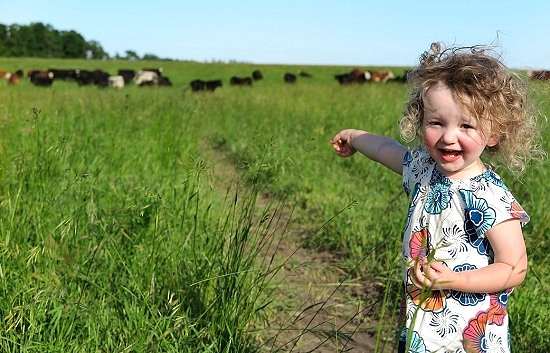Beef Cattle Marketing Options
for Grass Fed Cattle Farmers

Image Credit: USDA NRCS South Dakota, Flickr, CC BY-SA 2.0
What is the best beef cattle marketing strategy for farmers producing grass fed beef?
This article is going to discuss three different marketing options for grass fed beef, explain the opportunities and challenges of each, and explore the trends of the 21st-century beef consumer so you can choose the marketing pathway that is right for your cattle and your farm.
There are three broad options for marketing your grass fed beef.
- develop your own individual direct-marketing program;
- team up with other farmers - multiple farmers, one marketing pipeline;
- market your grass fed cattle through traditional beef cattle marketing channels (i.e. cattle auctions), while using pasture-based grazing strategies to lower your production costs.
Each has it's pros and cons.
Although there is no single right answer to what is the best way to market your grass fed beef cattle, I am going to show you why - if you want to direct-market your beef - you should be thinking about teaming up with other farmers, not going it alone in your marketing efforts. A marketing pipeline supplied by multiple farms is best-suited for reaching modern, urban, health-conscious beef consumers.
And if direct-marketing is not for you, then I'll explain how you can use low-cost pasture-based grazing strategies to reduce your production costs while continuing to market your grass fed cattle through the traditional commodity beef cattle markets.
Direct-marketing: building your own beef cattle marketing pipeline
In order to direct-market your own beef, you need to build a marketing pipeline.
That "marketing pipeline" consists of your network of customers - retail customers, wholesalers, stores, restaurants, and chefs - that will absorb your supply of beef, along with all the slaughter, butcher, packaging, transport, and storage efforts that enable you to reach those customers.
Undeniably, when you sell directly to consumers (direct-market), you will be able to command a considerable price premium over selling through the commodity cattle markets.
The growing pains of direct-marketing
But direct-marketing also requires a lot of extra work.
And direct-marketing has a lot of extra costs - advertising, customer service, labor to attend to a store front or a booth at a farmer's market, slaughter fees, butcher fees, delivery fees, freezing and storage fees, and the list goes on.
Direct-marketing means you are essentially adding a whole new business branch to your farm.
Just like building any real pipeline, developing a beef cattle marketing pipeline for your beef products takes time, patience, diligence, lots of planning, lots of legwork, and considerable initial investment without an up-front guarantee that your investment will pay off.
Don't expect a direct-marketing program for your beef to spring up overnight. It takes time to make connections, develop a reputation, create a relationship to customers, and fine-tune your supply chain to mesh with your customers' demands.
Most people who direct market their beef spend years developing their marketing pipelines. During those initial years, only a small portion of their overall beef supply was actually sold directly to retail customers while the rest of their cattle continued to sell through conventional commodity market channels because initially the capacity of their marketing pipeline was still far too small to absorb the full volume of their beef supply.
Part of the growing pains of direct marketing cattle is that buyers are notoriously fickle. Even after you begin finding customers, it will take time for your marketing pipeline to become a stable and reliable outlet for your grass fed beef. Customers won't easily forgive you if their first beef order is tough. Restaurants change suppliers like you change your shirt and chefs change their preferred cuts every time there is a rotation in their staff. Wholesalers find cheaper suppliers. Retail stores are loyal to their customers and to tight profit margins, not to new suppliers.
Meanwhile, the competition is growing for direct-marketed beef suppliers. While there still are not many large-scale grass fed beef suppliers, there are increasingly large numbers of small producers that you will be competing with.
The struggle to meet demand once the direct-marketing pipeline is established.
The flip-side of this struggle to develop your own marketing pipeline is that once the marketing pipeline reaches a critical mass, you can suddenly face the opposite problem - producing sufficient beef to meet demand.
At some point those initial lean years of developing relationships to your customers and building a reputation in your community will pay off. Once the snowball gets rolling, your own success can be challenging to manage as demand suddenly surges and potentially outstrips supply.
While that's a nice problem to have, it can be a significant challenge to solve in order to retain happy customers.
When your marketing pipeline reaches the point where it can absorb more beef than you can produce on your farm, that unfilled demand is not only leaving money on the table, but can also quickly lead to frustration among your clientele.
How do you produce enough beef to meet an exploding market demand?
Do you have a plan for how you will scale up production?
Answering these questions can be a challenge for individual farmers developing their own direct-marketing programs. Thankfully, there is one solution which can greatly simplify your beef cattle marketing, while creating a much more robust, flexible, and easily-scalable marketing pipeline to meet growing demand...
|
Page 1 / 2 |
|
Thumbnail Image Credit: USDA NRCS South Dakota, Flickr, CC BY-SA 2.0
|
Share: |
|


